Complete Solutions to EXERCISE of chapter OSCILLATIONS of Class 11 book with complete answers and questions
| Class 11 | PHYSICS |
| Chapter | OSCILLATIONS |
| PSEB | EXERCISE |
| Number Of Questions | 48 |
| Academic Year | 2023-24 |
Which of the following examples represent periodic motion?
03:22View SolutionWhich of the following examples represent (nearly) simple harmonic motion and which represent periodic but not simple harmonic motion? The rotation of earth about its axis.
03:19View SolutionWhich of the following examples represent (nearly) simple harmonic motion and which represent periodic but not simple harmonic motion? motion of an oscillating mercury column in a U-tube.
04:25View SolutionWhich of the following examples represent (nearly) simple harmonic motion and which represent periodic but not simple harmonic motion? motion of a ball bearing inside a smooth curved bowl, when released from a point slightly above the lower most point
04:37View SolutionWhich of the following examples represent (nearly) simple harmonic motion and which represent periodic but not simple harmonic motion? General vibrations of a polyatomic molecule about its equilibrium position.
04:07View SolutionFig. 14.23 depicts four x t plots for linear motion of a particle. Which of the plots represent periodic motion? What is the period of motion (in case of periodic motion)
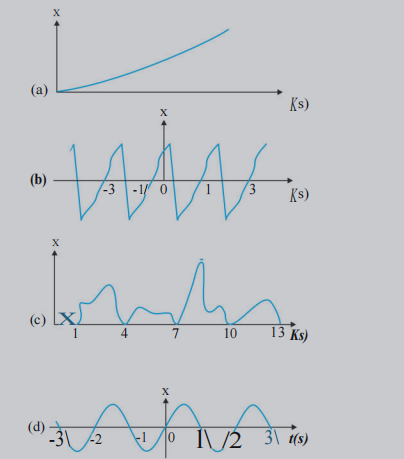 02:43View Solution
02:43View SolutionWhich of the following functions of time represent (a) simple harmonic, (b) periodic but not simple harmonic, and (c) non-periodic motion? Give period for each case of periodic motion (co is any positive constant): sin `omegat -cos omegat`
03:34View SolutionWhich of the following functions of time represent (a) simple harmonic, (b) periodic but not simple harmonic, and (c) non-periodic motion? Give period for each case of periodic motion (co is any positive constant):`sin^3omegat`
03:40View SolutionWhich of the following functions of time represent (a) simple harmonic, (b) periodic but not simple harmonic, and (c) non-periodic motion? Give period for each case of periodic motion (co is any positive constant):3 cos`((pi/4)-(2omegat))`
02:55View SolutionWhich of the following functions of time represent (a) simple harmonic, (b) periodic but not simple harmonic, and (c) non-periodic motion? Give period for each case of periodic motion (co is any positive constant):`cos omegat+cos3omegat=cos 5omegat`
03:13View SolutionWhich of the following functions of time represent (a) simple harmonic, (b) periodic but not simple harmonic, and (c) non-periodic motion? Give period for each case of periodic motion (co is any positive constant):exp `(-omega^2t^2)`
02:34View SolutionWhich of the following functions of time represent (a) simple harmonic, (b) periodic but not simple harmonic, and (c) non-periodic motion? Give period for each case of periodic motion (co is any positive constant): `1 +omegat +omega^2t^2`
02:27View SolutionA particle is in linear simple harmonic motion between two points, A and B, 10 cm apart. Take the direction from A to B as the positive direction and give the signs of velocity, acceleration and force on the particle when it is at the end A,
02:09View SolutionA particle is in linear simple harmonic motion between two points, A and B, 10 cm apart. Take the direction from A to B as the positive direction and give the signs of velocity, acceleration and force on the particle when it is at the end B,
01:24View SolutionA particle is in linear simple harmonic motion between two points, A and B, 10 cm apart. Take the direction from A to B as the positive direction and give the signs of velocity, acceleration and force on the particle when it is at the mid-point of AB going towards A,
01:57View SolutionA particle is in linear simple harmonic motion between two points, A and B, 10 cm apart. Take the direction from A to B as the positive direction and give the signs of velocity, acceleration and force on the particle when it is at 2 cm away from B going towards A,
01:41View SolutionA particle is in linear simple harmonic motion between two points, A and B, 10 cm apart. Take the direction from A to B as the positive direction and give the signs of velocity, acceleration and force on the particle when it is at 3 cm away from A going towards B, and
02:04View SolutionA particle is in linear simple harmonic motion between two points, A and B, 10 cm apart. Take the direction from A to B as the positive direction and give the signs of velocity, acceleration and force on the particle when it is at 4 cm away from B going towards A
01:39View SolutionWhich of the following relationships between the acceleration and the displacement x of a particle involve simple harmonic motion?
01:52View SolutionThe motion of a particle executing simple harmonic motion is described by the displacement function, x(t) = A cos `(omegat + phi)`. If the initial (t = 0) position of the particle is 1 cm and its initial velocity is `omega cm//s`, what are its amplitude and initial phase angle ? The angular frequency of the particle is `pi s^-1` s If instead of the cosine function, we choose the sine function to describe the SHM : x= B sin `(omegat+alpha)`, what are the amplitude and initial phase of the particle with the above initial conditions.
06:43View SolutionA spring balance has a scale that readsfrom 0 to 50 kg. The length of the scale is 20 cm. A body suspended from this balance, when displaced and released, oscillates with a period of 0.6 s. What is the weight of the body ?
03:28View SolutionA spring having with a spring constant `1200 N m^-1` is mounted on a horizontal table as shown in Fig. 14.24. A mass of 3 kg is attached to the free end of the spring. The mass is then pulled sideways to a distance of 2.0 cm and released.Determine the frequency of oscillations,
 02:02View Solution
02:02View SolutionA spring having with a spring constant` 1200 N m^-1` is mounted on a horizontal table as shown in Fig. 14.24. A mass of 3 kg is attached to the free end of the spring. The mass is then pulled sideways to a distance of 2.0 cm and released.Determine maximum acceleration of the mass,
 02:51View Solution
02:51View SolutionA spring having with a spring constant `1200 N m^-1` is mounted on a horizontal table as shown in Fig. 14.24. A mass of 3 kg is attached to the free end of the spring. The mass is then pulled sideways to a distance of 2.0 cm and released.Determine the maximum speed of the mass
 02:32View Solution
02:32View SolutionPlot the corresponding reference circle for each of the following simple harmonic motions. Indicate the initial (t =0) position of the particle, the radius of the circle, and the angular speed of the rotating particle. For simplicity, the sense of rotation may be fixed to be anticlockwise in every case: (x is in cm and t is in s). x =-2 sin `(3t+(pi//3))`
03:55View SolutionPlot the corresponding reference circle for each of the following simple harmonic motions. Indicate the initial (t =0) position of the particle, the radius of the circle, and the angular speed of the rotating particle. For simplicity, the sense of rotation may be fixed to be anticlockwise in every case: (x is in cm and t is in s). `x= cos (pi//(6-t))`
03:01View SolutionPlot the corresponding reference circle for each of the following simple harmonic motions. Indicate the initial (t =0) position of the particle, the radius of the circle, and the angular speed of the rotating particle. For simplicity, the sense of rotation may be fixed to be anticlockwise in every case: (x is in cm and t is in s). `x =3 sin (2pit+(pi//4))`
02:35View SolutionPlot the corresponding reference circle for each of the following simple harmonic motions. Indicate the initial (t =0) position of the particle, the radius of the circle, and the angular speed of the rotating particle. For simplicity, the sense of rotation may be fixed to be anticlockwise in every case: (x is in cm and t is in s). x=2 `cos pi`t
01:57View SolutionFigure 14.26 (a) shows a spring of force constant k clamped rigidly at one end and a mass m attached to its free end. A force F applied at the free end stretches the spring. Figure 14.26 (b) shows the same spring with both endsfree and attached to a mass m at either end. Each end of the spring in Fig. 14.26(b) is stretched by the same force F What is the maximum extension of the spring in the two cases ?
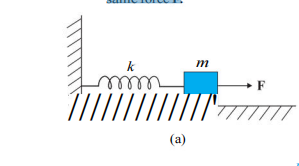
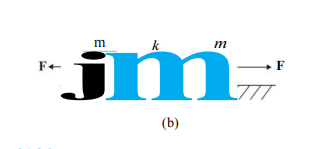 01:37View Solution
01:37View SolutionFigure 14.26 (a) shows a spring of force constant k clamped rigidly at one end and a mass m attached to its free end. A force F applied at the free end stretches the spring. Figure 14.26 (b) shows the same spring with both endsfree and attached to a mass m at either end. Each end of the spring in Fig. 14.26(b) is stretched by the same force F If the mass in Fig. (a) and the two masses in Fig. (b) are released, what is the period of oscillation in each case ?

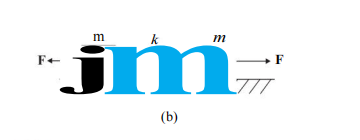 02:39View Solution
02:39View SolutionThe piston in the cylinder head of a locomotive has a stroke (twice the amplitude) of 1.0 m. If the piston moves with simple harmonic motion with an angular frequency of 200 `rad//min`, what is its maximum speed ?
01:26View SolutionThe acceleration due to gravity on the surface of moon is `1.7 m s^-2`. What isthe time period of a simple pendulum on the surface of moon if itstime period on the surface of earth is 3.5 s? (gon the surface of earth is `9.8 m s6-2`)
01:54View SolutionAnswer the following questions : Time period of a particle in SHM depends on the force constant k and mass m of the particle: T=`2pisqrt(m/k)`.A simple pendulum executes SHM approximately. Why then is the time period of a pendulum independent of the mass of the pendulum?
02:44View SolutionAnswer the following questions : The motion of a simple pendulum is approximately simple harmonic for small angle oscillations. For larger angles of oscillation, a more involved analysis shows that T is greater than `2pisqrt(l/g)` . Think of a qualitative argument to 9 appreciate this result
02:13View SolutionAnswer the following questions : A man with a wristwatch on his hand falls from the top of a tower. Does the watch give correct time during the free fall ?
01:53View SolutionAnswer the following questions : What is the frequency of oscillation of a simple pendulum mounted in a cabin that is freely falling under gravity ?
01:34View SolutionA simple pendulum of length 1 and having a bob of mass M is suspended in a car. The car is moving on a circular track of radius R with a uniform speed v. If the pendulum makessmall oscillations in a radial direction about its equilibrium position, what will be its time period ?
03:02View SolutionA cylindrical piece of cork of density of base area Aand height h floats in a liquid of density `rho_l`. The cork is depressed slightly and then released. Show that the cork oscillates up and down simple harmonically with a period T=`2pisqrt((hrho)/(rho_1g))` where p is the density of cork. (Ignore damping due to viscosity of the liquid)
05:28View SolutionOne end of a U-tube containing mercury is connected to a suction pump and the other end to atmosphere. A small pressure difference is maintained between the two columns. Show that, when the suction pump isremoved, the column of mercury in the U-tube executes simple harmonic motion.
03:05View SolutionAn air chamber of volume V has a neck area of cross section a into which a ball of mass mjust fits and can move up and down without any friction (Fig.14.27). Show that when the ball is pressed down a little and released , it executes SHM. Obtain an expression for the time period of oscillations assuming pressure-volume variations of air to be isothermal [see Fig. 14.27
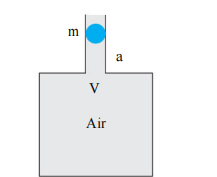 05:20View Solution
05:20View SolutionYou are riding in an automobile of mass 3000 kg. Assuming that you are examining the oscillation characteristics of its suspension system. The suspension sags 15 cm when the entire automobile is placed on it. Also, the amplitude of oscillation decreases by 50% during one complete oscillation. Estimate the values of : the spring constant k.
02:18View SolutionYou are riding in an automobile of mass 3000 kg. Assuming that you are examining the oscillation characteristics of its suspension system. The suspension sags 15 cm when the entire automobile is placed on it. Also, the amplitude of oscillation decreases by 50% during one complete oscillation. Esitmate the values of : the damping constant b for the spring and shock absorber system of one wheel, assuming that each wheel supports 750 kg.
06:06View SolutionShow that for a particle in linear SHM the average kinetic energy over a period of oscillation equals the average potential energy over the same period.
06:06View SolutionA circular disc of mass 10 kg is suspended by a wire attached to its centre. The wire is twisted by rotating the disc and released. The period of torsional oscillations is found to be 1.5 s. The radius of the disc is 15 cm. Determine the torsional spring constant of the wire. (Torsional spring constant `alpha` is defined by the relation J = `-alphatheta`, where J is the restoring couple and 0 the angle of twist).
02:34View SolutionA body describessimple harmonic motion with an amplitude of 5 cm and a period of 0.2 s. Find the acceleration and velocity of the body when the displacement is 5 cm.
03:53View SolutionA body describes simple harmonic motion with an amplitude of 5 cm and a period of 0.2 s. Find the acceleration and velocity of the body when the displacement is 3 cm.
02:55View SolutionA body describes simple harmonic motion with an amplitude of 5 cm and a period of 0.2 s. Find the acceleration and velocity of the body when the displacement is 0 cm.
02:43View SolutionA mass attached to a spring is free to oscillate, with angular velocity `omega`, in a horizontal plane without friction or damping. It is pulled to a distance `x_0` and pushed towards the centre with a velocity `v_0` at time t = 0. Determine the amplitude of the resulting oscillations in terms of the parameters `omega , x_0and v_0`.
03:28View Solution
EXERCISE questions and complete solutions for chapter OSCILLATIONS of PSEB of Class 11
